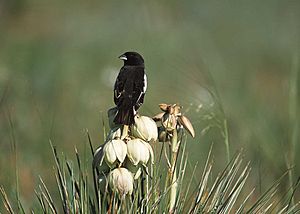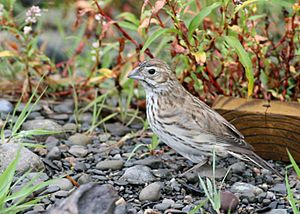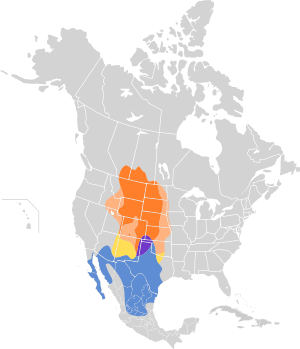Lark bunting facts for kids
Quick facts for kids Lark bunting |
|
|---|---|
 |
|
| Male lark bunting | |
 |
|
| Female lark bunting | |
| Conservation status | |
| Scientific classification | |
| Genus: |
Calamospiza
|
| Species: |
melanocorys
|
 |
|
| Synonyms | |
|
Fringilla bicolor J. K. Townsend, 1837 |
|
The lark bunting (Calamospiza melanocorys) is a medium-sized bird from the American sparrow family. It lives in central and western North America. This bird is also the official state bird of Colorado.
Contents
About the Lark Bunting's Name
The lark bunting is special because it's the only bird in its group, called a genus, named Calamospiza. It isn't closely related to other bird groups.
A scientist named John Kirk Townsend first described this bird in 1837. He called it Fringilla bicolor. Later, in 1885, Leonhard Hess Stejneger gave it the name Calamospiza melanocorys. This was because the first name was already used for another animal. The bird's own group, Calamospiza, was created by Charles Lucien Bonaparte in 1838.
What Does a Lark Bunting Look Like?
Lark buntings are small songbirds. They have a short, thick, bluish bill. A big white patch is on their wings. Their tail is fairly short with white tips on the feathers.
Male lark buntings look different during breeding season. Their whole body turns black. They have a large white patch on the upper part of their wing.
Non-breeding males and females look alike. They are grayish-brown with white stripes.
Lark Bunting Size
Here are some typical measurements for lark buntings:
- Length: 5.5 to 7.1 inches (14 to 18 cm)
- Weight: 1.3 to 1.5 ounces (35.3 to 41.3 grams)
- Wingspan: 9.8 to 11.0 inches (25 to 28 cm)
Where Do Lark Buntings Live?
The lark bunting is one of the most common birds in the grasslands of North America. They make their nests in prairie areas. These areas are found in central Canada and the mid-western United States.
In the fall, these birds migrate in large groups. They fly south for the winter. They go to southern Texas, Arizona, and the high plateaus of northern Mexico.
Lark Bunting Behavior
Reproduction and Nesting
Lark buntings usually build their nests in groups, but not too close together. Males fly high over their territory. They sing loudly as they fly down. This song tells other birds that the territory is theirs. Their song is a mix of whistles and trills. They also make a soft hoo call.
The nest is shaped like an open cup. It is built on the ground in a grassy spot.
Lark buntings generally form pairs for nesting. However, sometimes males and females will mate with other birds too. This can lead to competition between males and between females for mates. Many males might not find a partner. This is often because there are more males than females.
Female lark buntings can be very picky about their mates. What they look for in a male can change a lot each year! One year, they might prefer males with more black feathers. Another year, they might like males with bigger wing patches or different beak sizes. This changing preference helps keep many different traits in the male lark bunting population.
Males are not very protective of their territory before mating. But studies show that good territory features, like having shade, can help females have more success with their nests. Even so, male aggression levels don't seem to change much.
What Do Lark Buntings Eat?
Lark buntings mainly look for food on the ground. In summer, they mostly eat insects. In winter, they switch to eating seeds. Sometimes, they take short flights to catch insects. Outside of the nesting season, they often feed together in large groups.
Colorado's State Bird
The lark bunting has been the official state bird of Colorado since 1931.
Lark Bunting Status
The number of lark buntings has been going down. This is mainly because their natural prairie homes are disappearing.
Images for kids
See also
 In Spanish: Chingolo albinegro para niños
In Spanish: Chingolo albinegro para niños





